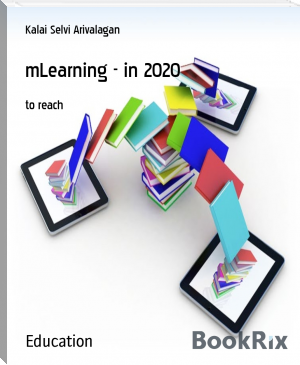INNOVATIONS IN SCIENCE, TECHNOLOGY AND MATHEMATICS EDUCATION IN NIGERIA, Ebele C. Okigbo, Nneka R. Nnorom, Ernest O. Onwukwe [best reads .TXT] 📗

- Author: Ebele C. Okigbo, Nneka R. Nnorom, Ernest O. Onwukwe
Book online «INNOVATIONS IN SCIENCE, TECHNOLOGY AND MATHEMATICS EDUCATION IN NIGERIA, Ebele C. Okigbo, Nneka R. Nnorom, Ernest O. Onwukwe [best reads .TXT] 📗». Author Ebele C. Okigbo, Nneka R. Nnorom, Ernest O. Onwukwe
Igweh, A.U. (2012). Combined effect of computer tutorial and drill on senior secondary school students’ achievement, interest, and retention in basic electronics in Lagos state. Unpublished Doctoral dissertation University of Nigeria Nsukka.
Keziah, A. A. (2011). Using computer in science class: The interactive effect of gender.Journal of African Studies and Development,3(7); 131-134.
Michael A. F., Omiola, M. A., Anoyemi, E. & Mohammed R. E. (2014). Effect of computer assisted instructional package on the performance of students in mathematics in Ilorin metropolis. European Scientific Journal, 10 (25); 57 – 78.
Okafor, J.C. (2004). Women in science and technology: Towards entrenching an enduring democracy in Nigeria. International Journal of Gender and Health Studies, 2(1&2); 96-104.
SECTION TWO
INFORMATION COMMUNICATION TECHNOLOGY (ICT) IN SCIENCE, TECHNOLOGY AND MATHEMATICS EDUCATION
IMPROVEMENT OF EDUCATORS IN HIGHER INSTITUTION AS A MEANS OF REDUCING LEARNING DIFFICULTIES IN ICT CLASSROOMS
Peace O. Ezzeh
&
Kate C. Okoh
Abstract
Information and communication technology (ICT) is a great way to address the issue of learning difficulties in the classroom and what better way to achieve this than through the proper education of the educators on the way ICT can be used in the classrooms. Therefore, this study examined the improvement of educators in higher institution as a means of reducing learning difficulties in ICT classrooms. Three research questions guided the study and descriptive survey research design was adopted. The study was carried out in F.C.E(T), Asaba, Delta State. The population comprise of the lecturers from various departments. 178 lecturers were sampled from the institutions using simple random sampling technique. Educators computer knowledge and use of Technology (ECKUT) questionnaire was the instrument for data collection. Mean and standard deviation were used to answer the research questions. The result showed that educators rarely use ICT tools in the preparation of lesson notes. These educators are ready to embrace ICT as they agreed that it has an impact on the students and it will make the classrooms more interactive thereby combating learning difficulties. Based on the findings, the study recommended among others that free internet services should be provided by the school authorities or government to both students and lecturers alike so as to make the move towards ICT.
Keywords: Learning difficulties, Educators, ICT Classrooms, Higher institutions
Introduction
Learning is the process of acquiring education or skills. Evidence of research has re-emphasized severally that it is the teacher that makes both available to the willing and dedicated learner (Amobi, 2014). The 1996 Education Act defines a person with a learning difficulty as one who has a significantly greater difficulty in learning than majority of learners of the same age. This definition covers a wide spectrum of needs ranging from learners with relatively mild or Moderate difficulties (MLD) to individuals who have severe learning difficulties (SLD) or profound and Multiple learning difficulties (PMLD).
Education is an integral part of any community and everyone has a right to learn and be taught in a classroom but what happens in a situation where the students are slow in learning? A significant number of students with learning disabilities or learning difficulty require assistance and support in their learning. The use of information and communication technology (ICT) and use of the internet can play a major role in shaping the knowledge and skill of these students. In order for this to be achieved, the educators have a vital role to play in the lives of such students.
One of the problems in working in this area is terminology with the terms: learning difficulties, children at risk, special needs and learning disabilities all being used in different countries and different context to describe these children. Learning difficulty will be used to cover all the others. Learning difficulty according to Rivalland (2000) is seen as a generic term. It refers to a heterogeneous group of students who have significant difficulties in the acquisition of literacy and numeracy and who are not covered in the common wealth’ definition of a student/child with a disability. Learning disability is believed to be intrinsic to the individual and not a direct result of other conditions or influences, Gould (2005) describes learners with learning difficulty as learners with an average to above average intelligence, with normal vison and hearing who receive the same teaching experience as other learners of their age but who are under achievers. Adam and Tartnall (2014) placed learning difficulty as a large group of children who need extra assistance with schooling. learning disabilities refers to students who constitute a small subgroup that exhibit severe and un explained problems as shown in the venn diagram of fig 1.
Fig.1: Learning difficulty Diagram
Policies where put in place for some time in countries to integrate students with learning difficulties into the mainstream, but this has not always provided the learning environment for their students (Shaw, Grimes & Bulman, 2005)
Sheldon (2018) pointed out that there are number of possible factors that can cause learning disabilities some of these include:
1. Heredity – Learning disabilities sometimes run in the family so these people might have parents or relatives with learning disabilities.
2. Problems during pregnancy and birth: This can also be caused by illness or injury during or before birth. It can also be used by low birth weight, lack of oxygen, drug and alcohol use during pregnancy and premature or prolonged labour.
3. Accidents after birth: Head injuries, nutritional deprivation and exposure to toxic substances (ie lead) can contribute to learning disabilities.
Combating Learning Disabilities with the Use of ICT
With the advance in the use ICT and the rate of internet accessibilities, there has been changes in the way education is delivered to students of all ages and abilities in Nigeria. Technology utilized in the classroom setting is referred to as Assistive Technology (AT) helps the teacher in their role as educators and facilitators for easy communication, exploration and organization of the students. The difficulty to be handled determines the type of AT that will be use the teachers also need to be ready and prepared to use these tools in the classrooms.
ICT originally is applied to serve as a means of improving efficiency in the educational process (Jones & Knezek, 2013). Furthermore, it has been shown that the use of ICT in education can help improve memory retention, increase motivation and generally deepens understanding (Dede, 2018). Thus, technology can effectively improve teaching and learning abilities, hence increasing learners‟ performances. As Castro, C. (2003) and Cawthera, A, (2000) posit, ICT has the means to aid in the preparation of learners by developing cognitive skills, critical thinking skills, information access, evaluation and synthesising skills. In addition, ICT provides fast and accurate feedback to learners (Becta, 2003). It is also believed that the use of ICTs in education could promote “deep‟ learning and allow educators to respond better to different needs of different learners ( Lau& Sim, 2008). According to Newhouse (2012), ICT-supported learning environments could be beneficial to a constructivist teaching approach
What are the challenges with respect to learning difficulties in ICT
The use of ICT in teaching is a relevant functional way of providing education to learners that will assist in imbibing in them the required capacity for the world of work. In order to meet with societal, tertiary institutions round the world are moving rapidly to incorporate ICTs into all aspects of their core business of teaching and learning (Aniedi and Effiom, 2009) cited by Abanobi & Abanobi 2016).
Unfortunately, some educators in tertiary institutions do not recognize and utilize the opportunities presented by ICT in order to accommodate those with learning difficulty. Adeyemo (2010) noted that the problem of information technology illiteracy was a serious one among teachers in the country as it cuts across primary, secondary schools and tertiary institutions. He also said that many teachers in the country did not have basic computer appreciation skills and noted that the problem was a hindrance to efforts at achieving the use of computers for educational purposes in schools and some of these educators lack the relevant knowledge that would aid the application of ICT skills in their classrooms. This has resulted in the low utilization of ITS among teachers in the teaching/learning situation (Yusuf, 2005)
The rapid growth in ICT has brought remarkable changes in the twenty-first century, as well as affected its adoption and integration by teachers in teaching-learning process. The effective integration of technology into classroom practices poses a challenge to teachers and administrators. According to Guma, Faruque and Khushi(2013), Teachers and administrators have strong desire for the integration of ICT into education but they encountered many barriers to it which includes but is not limited to the following
These findings therefore have implications for training the teachers to become regular users of ICT focusing on acquiring basic ICT skills. For successful integration of ICT into teaching-learning, the factors that positively influenced teachers‟ and administrators‟ use of ICT in education include teachers‟ attitudes, ICT competence, computer self-efficacy, teaching experience, education level, professional development, accessibility, technical support, leadership support, pressure to use technology, government policy on ICT literacy, and technological characteristics. However, the presence of all factors increases the probability of excellent integration of ICT in teaching-learning process. Therefore, the training of teachers in the pedagogical issues should be increased if teachers are to be convinced of the value of using ICT in their teaching-learning process (Guma, Faruque & Khushi 2013),
Various competencies must be developed throughout the educational system for ICT integration to be successful:
Teachers: According to Borghans, L & Weel, B (2014), Teacher professional development should have five foci: 1) skills with particular applications; 2) integration into existing curricula; 3) curricular changes related to the use of IT (including changes in instructional design); 4) changes in teacher role( 5) underpinning educational theories. Ideally, these should be addressed in pre-service teacher training and built on and enhanced in-service. In some countries, like Singapore, Malaysia, and the United Kingdom, teaching accreditation requirements include training in ICT use. ICTs are swiftly evolving technologies, however, and so even the most ICT fluent teachers need to continuously upgrade their skills and keep abreast of the latest developments and best practices.
Education administrators: Leadership plays a key role in ICT integration in education. Many teacher- or student-initiated ICT projects have been undermined by lack of support from above. For ICT integration programs to be effective and sustainable, administrators themselves must be competent in the use of the technology, and they must have a broad understanding of the technical, curricular, administrative, financial, and social dimensions of ICT use in education (Smarkola, 2007).
Technical support specialists: Whether provided by in-school staff or external service providers, or both, technical support specialists are essential to the continued viability of ICT use in a given school. While the technical support requirements of an institution depend ultimately on what and how technology is deployed and used, general competencies that are required would be in the installation, operation, and maintenance of technical equipment (including software), network administration, and network security (Plair, 2008). Without on-site technical support, much time and money may be lost due to technical breakdowns.
In the Rural areas, for example, one of the major obstacles to optimizing computer use in high schools has been the lack of timely technical support. In some extreme cases involving schools in remote areas, disabled computers take months to be repaired since no technician is available in the immediate vicinity and so the computers have to be sent to the nearest city hundreds of kilometres away.
Content developer: Content development is a critical area that is too often overlooked. The bulk of existing ICT-based educational material is likely to be in English (see section on language and content below) or of little relevance to education in developing countries (especially at the primary and secondary levels). According to Olatokun, (2007), there is a need to develop original educational content (e.g., radio programs, interactive multimedia learning materials on CD-ROM or DVD, Web-based courses, etc.), adapt existing content, and convert print-based content to digital media. These are tasks for which content development specialists such as instructional designers, scriptwriters, audio and video production specialists, programmers, multimedia course authors, and web-developers are





Comments (0)